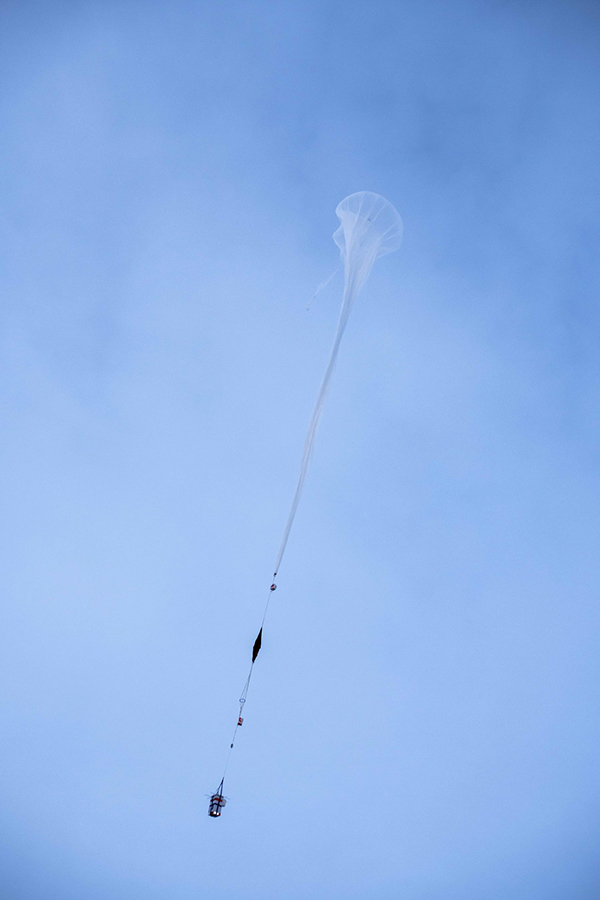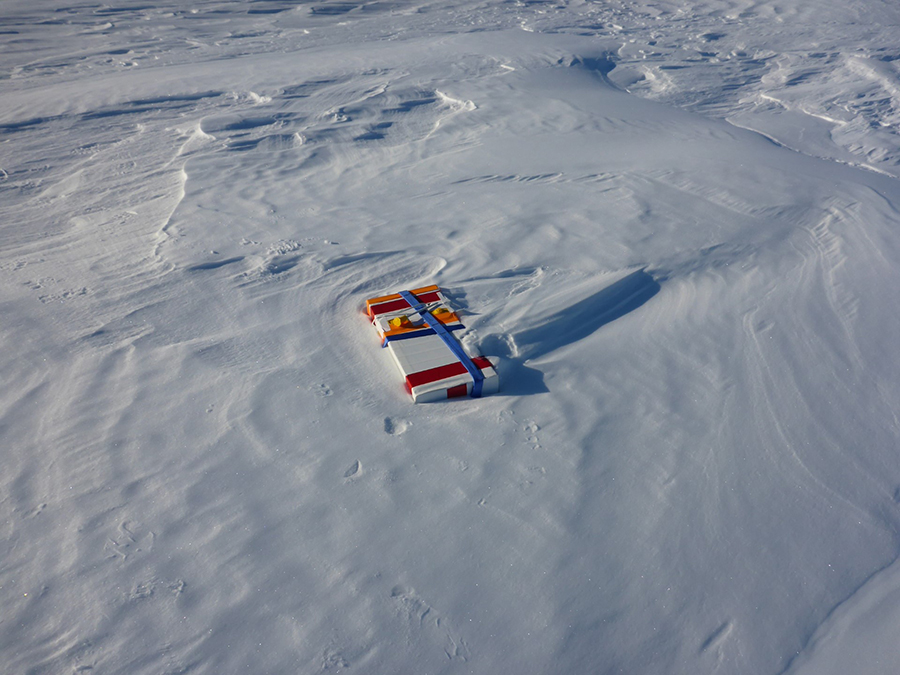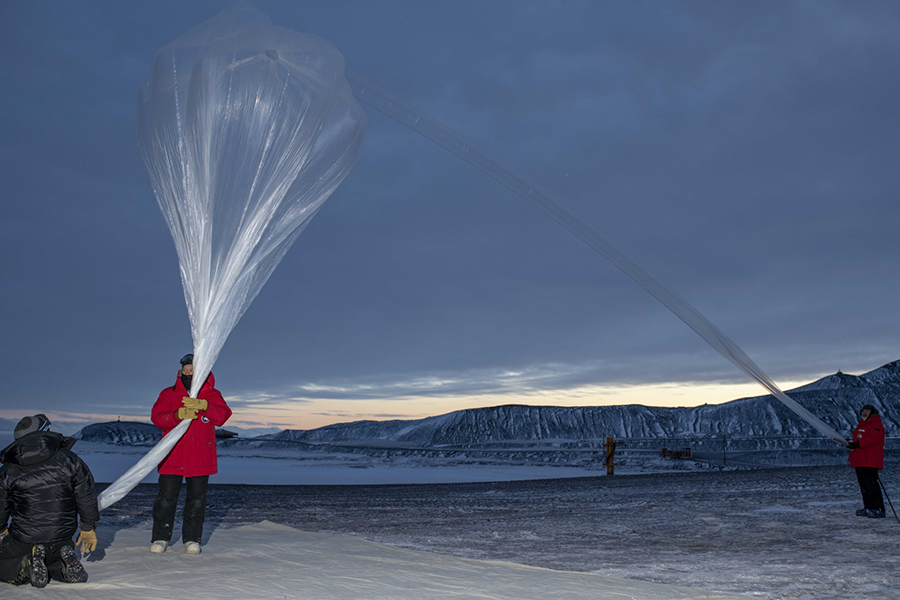Chasing Aerosol GhostsHow Not Finding Atmospheric Particles Helps Scientists Predict the Future of ClimatePosted July 28, 2020
For a big mass of air, the Earth's upper atmosphere is a complicated place. The changing seasons cause temperatures and pressures to rise and fall, altering the characteristics of the planet's atmospheric layers, sometimes dramatically. Atmospheric models go a long way to predict how changing atmospheric conditions affect the planet's climate, but there are so many factors that go into these equations that scientists are constantly double-checking whether predicted results match what they observe. They don't always agree at first. One recent, surprising result prompted atmospheric scientist Terry Deshler of the University of Colorado at Boulder and his team to travel to Antarctica during the cold, dark austral fall to measure stratospheric aerosols and polar stratospheric clouds using instruments mounted to large helium balloons. 
Photo Credit: Tom Reese
Next to the water treatment facility at McMurdo Station, the science team inflates a balloon to carry their particle counters into the upper atmosphere.
"We saw a rather regular feature of an enhanced layer of small particles at about 25 kilometers in the stratosphere [in August and September]," Deshler said. "The surprise was the model also predicted a not as significant feature, but a similar kind of feature in the austral fall, so the April and May timeframe." There in their computer model, at a time of year when they shouldn't be there, was a mass of newly-formed aerosols, tiny droplets of condensed water and sulfuric acid that hang in the upper atmosphere. This predicted particle layer could dramatically affect their atmospheric models, so the team needed to check it out. However, when the team flew their instruments over Antarctica during the austral fall of 2019, that model-predicted layer was nowhere to be found. "We didn't see that particle layer in the austral fall," Deshler said. "The measurements of that part of the project didn't agree with what the model run in 2010 predicted." After failing to detect the particle layer, the team returned home to review their calculations. With the newly collected data as a guide, they made a few updates to their model to better reflect the initial conditions they measured in 2019 and reran their simulations. This time, the updated model matched what they saw in the sky, there was no autumn particle layer. "When the model was rerun, it more or less agreed with the measurements," Deshler said. Making sure atmospheric models are as accurate as possible is an important and ongoing effort for researchers working to refine climate predictions. Scientists often have to go to great lengths, even to the ends of the Earth, to capture the raw data needed. The research is supported by the National Science Foundation, which manages the U.S. Antarctic Program. Aerosols at the Edge of SpaceThese stratospheric aerosols suspended in the upper atmosphere can influence the planet's climate by affecting the amount of sunlight reaching the surface of the Earth. They usually form from vapors condensing around floating dust particles, but if conditions are just right, the vapors can spontaneously solidify into tiny particles as well. Over time, as they disperse to lower levels of the atmosphere, they help to form polar stratospheric clouds during the polar winter that affect climate as well. "All the [climate] models have to account for this if you want to [compute] global warming correctly because these particles scatter sunlight back into space," Deshler said. "It's kind of a cooling shield in the stratosphere." 
Photo Credit: Tom Reese
Carried aloft by a helium balloon, the team's particle counters fly into the sky.
Climate models are sophisticated predictive simulations of the planet's climate and are key to predicting what the future holds for the planet as its temperature warms. They need to be as accurate as possible because computing climate patterns is deeply complex. Often seemingly insignificant changes in the models' starting parameters can result in big differences once all the calculations are run. "The models need to get that right because it scatters a few percent of the sunlight back into space which creates a direct cooling effect," Deshler said. "If global climate models ignore the stratosphere, then they cannot reproduce the temperatures that are observed." Scientists have long known that stratospheric aerosols coalesce high over Antarctica every austral springtime. When the team's atmospheric model predicted another round of new particle formation in the fall, it had scientists concerned that they had missed an important factor in their climate and ozone models, and needed to verify that they were there. In addition, when these particles eventually reach lower levels in the atmosphere, they seed polar stratospheric clouds which are a major driver of ozone depletion. Measuring the onset of polar stratospheric clouds in the austral fall was a second aspect of the Deshler team's balloon research as they form in layers too thin to be observed by satellite sensors. These clouds are unlike most clouds visible in the sky. They form in the upper atmosphere around the Earth's poles, usually at altitudes between about 50,000 and 80,000 feet. There are a few different types of polar stratospheric clouds, but the most common, and the kinds that Deshler and his team were studying, are actually formed mostly out of nitric and sulfuric acid rather than water droplets. This nitric and sulfuric acid enables a chemical reaction in the upper atmosphere that releases chlorine molecules that go on to destroy the planet's fragile ozone layer in the polar regions. Though it can take a year or more after their formation for stratospheric aerosols to disperse down and seed polar stratospheric clouds, the aerosol particles drive the formation of these clouds. "It really controls the ozone budget globally, the presence of these particles," Deshler said. "If you don't have those particles in your model you won't get ozone right." Counting ParticlesMeasuring the newly formed aerosol particles is difficult. The masses they make up are so thin and wispy, they're likewise virtually undetectable from space. "These particles are very small, between 10 and 20 nanometers," Deshler said. They're invisible to a satellite measurement, and they could only be detected by some rather specialized equipment that we have developed." Instead, Deshler and his team developed compact particle counters carried aloft on helium balloons into the stratosphere to measure them directly. 
Photo Credit: Ian Geraghty
Months after their launch, members of the science team returned to recover the particle counters, many of which had been nearly buried under the winter's blowing snow.
"These instruments weigh about six or seven pounds or so all together," Deshler said. "The highest altitudes we reached were about 35 kilometers." Once airborne, the devices sucked in air to count the particles suspended in the atmosphere. "You have a chamber and you draw an airstream through the chamber," Deshler said. "You illuminate the chamber with a bright light, in this case a laser, and as a particle passes through the beam it scatters the light. The scattered light is picked up by a photosensor." The photo sensor counts the number of particles that pass into the chamber. By counting the number of particles per second that enter the instrument, the team can calculate the concentration of the particles that make up the stratospheric aerosol. If they had seen a sudden increase in the concentration of them, it would have been evidence of new particle formation. "It's a little tricky to get these particles big enough to be sensed with a light beam, because particles less than 100 nanometers are invisible to a normal light beam. They're too small to scatter the light," Deshler said. "We have a growth chamber attached to the instrument before it gets to the aerosol counter." The growth chamber supersaturates the surrounding air with ethylene glycol vapor and cools the air around the particles, causing the glycol to condense onto any surface nearby. "If there's a particle in the airstream, [the glycol] will condense on those particles. Then they grow large," Deshler said. "We'll grow particles from 10 nanometers up to 500 nanometers in a matter of a few seconds, so then when they pass through the aerosol counter they're easily counted." The team launched a total of nine balloons from McMurdo Station over the course of the 2019 austral winter. When released on the ground the balloons measured about 12 feet across, but when they reached their peak altitude of about 35 kilometers, they swelled to about 100 feet across. In addition to the particle counters, the balloons carried a second instrument to look at the effect that falling space dust has on the stratospheric aerosols. "Micrometeorites, are very small particles. Basically smoke," Deshler said. "Most of the climate models that have an aerosol component to it have a fairly significant meteoric input into the stratosphere." This dust helps drive the formation of the stratospheric aerosol. Because of changing temperatures and pressures during the polar springtime, the upper atmosphere gets supersaturated with sulfuric acid vapor. The micrometeorites act as "nucleation points," a surface for the sulfuric acid to condense around and form the particles that make up the stratospheric aerosol. Deshler and his team wanted to see how big of an influence these particles had on the formation of stratospheric aerosol so they could further improve their atmospheric climate models. To characterize this space dust, Deshler flew a second instrument on the balloon that boiled away any condensed sulfuric acid around the dust, and counted how many dust particles it saw as it flew higher. "If the fraction of dust was increasing as the balloon ascended… that would suggest that there is a source region above, probably in the mesosphere, where these micrometeorites are entering the atmosphere burning up and leaving this smoke residue which subsides over time." After collecting and transmitting back their data, the devices separated from their balloons and dropped towards the ice shelf below, deploying small parachutes for a nice soft landing. "It parachutes down, and then we have locating devices on the instruments so that once they touch down on the surface of the ice, they ping out a location for maybe a day or so and then they go quiet," Deshler said. "They just sit there and wait… It has a listening mode and if it hears the instrument that we use to find it, it wakes back up and begins pinging again." Recovering the InstrumentsIn November and December, a smaller team traveled back to McMurdo Station to fly out and retrieve the devices from where they landed along the Ross Ice Shelf. "Most of the science data was telemetered by radio, so they got real-time data," said Tom Reese of the University of Colorado at Boulder. "On the instruments, in addition to the science data there was also some secondary housekeeping data on instrument performance, power supply, temperatures all that sort of stuff recorded on SD cards." 
Photo Credit: Ian Geraghty
Ian Geraghty takes a GPS reading while recovering one of the team's instruments.
In addition, the team hopes to reuse the devices in a future season in order to collect even more data. "They're going to go back and rehab the instruments, because some of them had pretty hard landings but most of the stuff looked good as near as we can tell," Reese said. "They're going to recalibrate them and make sure that everything functions." Using the GPS data transmitted by each device when it first landed, the team flew out in helicopters to the areas where they touched down, then pulled out their trackers to locate the device. Some of the trackers worked, some didn't and the team had to try to look for the devices the old fashioned way. "We knew where it landed but we didn't know did it stay there?" Reese said. "It could have blown quite a ways. In fact, almost all of them did. They went about two-tenths of a mile." Recovering the devices was no small feat. Deshler had been down to McMurdo Station previously and had successfully recovered instruments that were flown during past austral winters. The new instruments flown in 2019 were smaller and would have had more time on the ice than those flown in previous winters. "Will the new locating devices work? Are they going to be buried in snow? Are they going to be scattered across the ice shelf in a million pieces?' Nobody knew," Reese said. "So I think that was pretty successful, I think we actually may have done better than what was thought we were going to be able to do. We have some ideas on how to improve things." With the instruments back at the University of Colorado at Boulder, the team is working on processing their data and upgrading their equipment for a future field season. "We want to get two field seasons done because we'd like to back up the measurements that we already had," Deshler said. "We would like to check again for the meteoric impact into the stratosphere using instruments that can get even higher." NSF-funded research in this story: Terry Deshler, University of Colorado at Boulder, Award No. 1745008. |



For USAP Participants |
For The Public |
For Researchers and EducatorsContact UsU.S. National Science FoundationOffice of Polar Programs Geosciences Directorate 2415 Eisenhower Avenue, Suite W7100 Alexandria, VA 22314 Sign up for the NSF Office of Polar Programs newsletter and events. Feedback Form |


